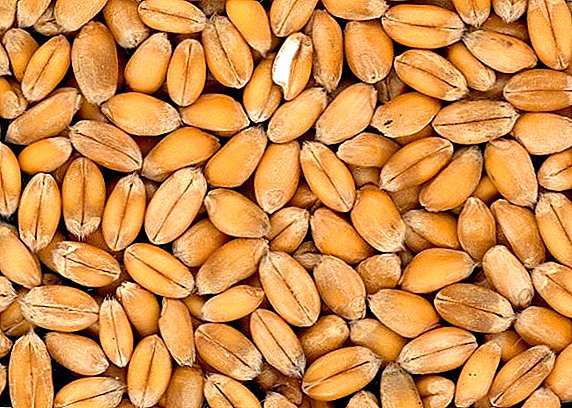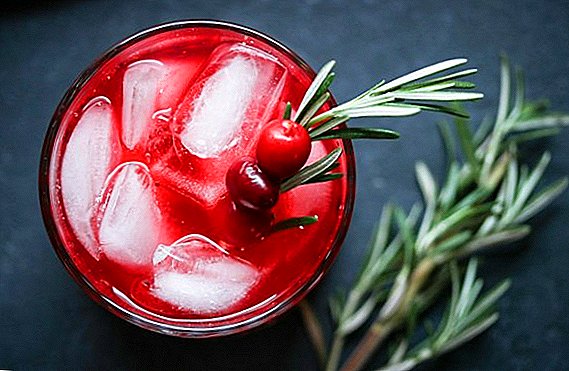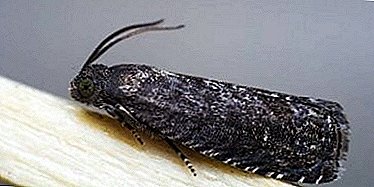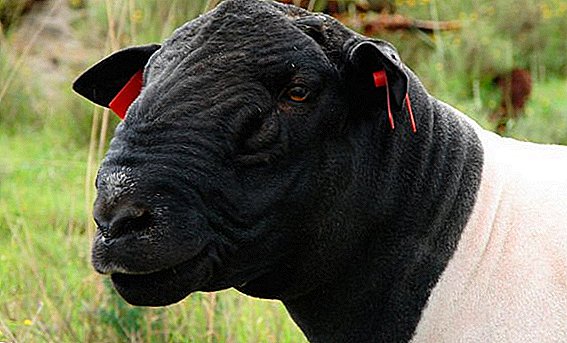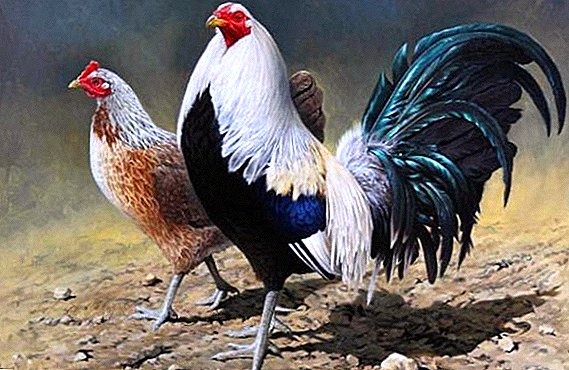 The market dictates its conditions to breeders who annually produce new, more productive meat and egg cross-country chickens. At the same time, no attention is paid to fighting breeds due to low productivity, as well as the laws of many countries that prohibit cockfighting. Today we will consider the popular American fighting breed of chickens, we will tell about the main features and conditions of its content.
The market dictates its conditions to breeders who annually produce new, more productive meat and egg cross-country chickens. At the same time, no attention is paid to fighting breeds due to low productivity, as well as the laws of many countries that prohibit cockfighting. Today we will consider the popular American fighting breed of chickens, we will tell about the main features and conditions of its content.
The origin of the breed
The breed was created in 1890 based on the following fighting varieties: Old English, Shamo, Cuban, Belgian, Brazilian. The result was a breed that was superior in quality to the previously used Asian fighting chickens. “Americans” not only performed well at competitions, but were also less demanding of conditions of detention. 
Appearance and physique
Individuals must comply with the following breed standards:
- torso - powerful, large, oval;
- sternum - bulging, rounded;
- back - muscular, broad;
- head is small, oval;
- beak - long, thin, bent at the end;
- earrings - small, bright red;
- crest - small, leaf-shaped or pod-like;
- the plumage is smooth, rather dense;
- feet - long, powerful, painted gray.
Did you know? In some European countries, competitions are held in rooster singing. Especially for this, in Germany, the breed of Bergenian warblers was bred, whose members sing four times longer than the cocks of other breeds.
Direction and character
This breed is not in vain considered the best in the world. Both chickens and roosters are brutal and ruthless towards their opponents. They do not have the concept of fear, so they are not afraid to attack targets that exceed them in weight or size.  Birds are in conflict not only with "strangers", but also within their own socium. And if the chickens are more or less calm, then the roosters will not be able to divide the influence and territory, so they will fight to the last.
Birds are in conflict not only with "strangers", but also within their own socium. And if the chickens are more or less calm, then the roosters will not be able to divide the influence and territory, so they will fight to the last.
"Americans" are not devoid of intelligence, therefore, they can be successfully trained, as well as accustomed to certain actions in a given situation. This allows the rooster to perform better in competitions, anticipating the actions of the enemy.
Read also about other fighting breeds of chickens: Azil, Sumatra, Kulangi.
Color and plumage
The standard does not limit variations in the color of the plumage, as there are a huge number of different combinations of colors and shades. The most common colors are silver and gold.
Feathers are tight to the skin, so the bird seems to be taut and muscular. Roosters have the largest number of feathers located on the mane and lower back. Chickens are deprived of abundant plumage in these places, so their body appears small and thin, and the tail is disproportionately large. 
Productive characteristics
American combat has the following performance indicators:
- Sexual maturity is 7 months.
- Rooster weight - 2-2.5 kg.
- Chicken weight - 1.7-2.2 kg.
- Egg production - 100-140 pieces.
- Egg weight - 50 g
- Duration of productivity - 3-5 years.
Hatching instinct
The efforts of breeders were also aimed at achieving a natural breeding of offspring. Chickens not only carry well, but also have a well-developed maternal instinct, so the hen cares for its offspring, protecting it from its family and strangers. The hatchability of offspring is 87%.
Important! Adult bird and young growth quickly adapt to both cold and hot climates.
Complexity of the content
Room Adults are undemanding to the temperature of the content, so in the cold season they can do without additional heating. The coop must be ventilated all year round with the help of ventilation. In winter, the air exchange should be reduced to a minimum. Straw or special granules of neutral color are used as litter (so that chickens do not eat them).  Insulation. This breed is aggressive, so it must be kept isolated from other animals (not only birds). Cocks additionally tied to any support, so that they do not conflict with each other.
Insulation. This breed is aggressive, so it must be kept isolated from other animals (not only birds). Cocks additionally tied to any support, so that they do not conflict with each other.
Walking In order for physical development to take place at the proper level, and for the representatives of the breed where it was possible to throw out their energy, it is necessary to equip a closed walking yard in which chickens can not only actively move, but also eat. The walking yard is necessary to cover the roof so that the bird does not run away.
Check out the recommendations for building a chicken coop: how to insulate, what floor to make, lighting, how to equip - build a nest, perches, automatic feeder (from PVC pipes, bunker), drinking trough (from a bottle).
What to feed
Consider the diet of fighting chickens, which will help to achieve optimal weight gain, as well as provide the Americans with energy.
Adult family
It is important to remember that when overfeeding the bird does not get fat. For this breed, the appearance of fatty deposits is uncharacteristic, so do not be afraid of such an outcome.  The diet of fighting chickens does not differ from the feeding of universal breeds. They also need to be given combined feeds that are rich in vitamins and minerals. In the warm season, be sure to offer grass, as well as tops of agricultural plants. In the cold season, root vegetables are given, and in the compound feed they increase the dose of grass meal.
The diet of fighting chickens does not differ from the feeding of universal breeds. They also need to be given combined feeds that are rich in vitamins and minerals. In the warm season, be sure to offer grass, as well as tops of agricultural plants. In the cold season, root vegetables are given, and in the compound feed they increase the dose of grass meal.
In order not to waste time on the creation of their own composition of feed for the "Americans", just buy food for adult birds of the egg direction. When buying, pay attention to the fact that the percentage of proteins and fats should not be high.
Learn more about feeding laying hens: the rate of feed per day; types of animal feed, mash, bran and wheat germinated in the diet of chickens; feeding for chickens - live food, yeast, fish oil, meat and bone meal.
Chickens
From the first days of life, chickens are fed with a mixture of finely chopped boiled eggs with steamed crushed cereals (wheat, corn, barley). Such mash is quickly and easily absorbed, and also fills the body of the bird with all the necessary nutrients.
Also from the first days give vitamins and minerals. If possible, you can offer greens or roots. In the absence of these products, young animals are given premixes in small quantities. 
Preparation for the exhibition
In order for the pets not only to fight well, but also to look great, they need to create ideal conditions, namely, to avoid prolonged exposure to direct sunlight, regularly change the litter, feed vitamins that improve color.
Long before the exhibition, it is necessary to train cocks and chickens. To train the legs, the individual is placed in big running wheelin which the bird should be a few hours. Also, roosters are taught to respond to sudden movements in various conditions.
It is necessary to check daily the integrity of the skin, the health of the paws and wings. In case of detection of wounds, sprains or fractures, the problem must be solved immediately or refuse to participate in the exhibition / battles.
Did you know? In Japan, there is a cult of worshiping chickens. It was in this country that rocks were bred, with tail feathers reaching a length of 7 meters. Such individuals are of purely aesthetic value.
Disease resistance to disease
In this breed no characteristic diseasestherefore, the safety of young stock reaches 95%. It should be understood that if the bird is in inappropriate conditions, it can become infected with a viral or bacterial infection. Prevention consists in regular disinfection of the room, drinkers and feeders. 
Advantages and disadvantages
Pros:
- rapid maturation compared with other fighting breeds;
- the presence of a developed maternal instinct;
- a strong character;
- undemanding to conditions of detention;
- strong immunity;
- good egg production (at the level of universal breeds).
Minuses:
- insulation is required, as well as a properly equipped room and paddock;
- before slaughter, you must enter a special diet, so that the meat was soft;
- From September to February inclusive, chickens do not rush.
Video: American fighting chickens
American warrior breed remains relevant and popular even after the ban on fighting, but breeding these chickens only for meat or eggs is unprofitable.





